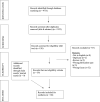Policy Advocacy and Nursing Organizations: A Scoping Review
- PMID: 34787526
- PMCID: PMC8600587
- DOI: 10.1177/15271544211050611
Policy Advocacy and Nursing Organizations: A Scoping Review
Abstract
Policy advocacy is a fundamental component of nursing's social mandate. While it has become a core function of nursing organizations across the globe, the discourse around advocacy has focused largely on the responsibilities and accountabilities of individual nurses, with little attention to the policy advocacy work undertaken by nursing organizations. To strengthen this critical function, an understanding of the extant literature is needed to identify areas that require further research. We conducted a scoping review to examine the nature, extent, and range of scholarly work focused on nursing organizations and policy advocacy. A systematic search of six databases produced 4,731 papers and 68 were included for analysis and synthesis. Findings suggest that the literature has been increasing over the years, is largely non-empirical, and covers a broad range of topics ranging from the role and purpose of nursing organizations in policy advocacy, the identity of nursing organizations, the development and process of policy advocacy initiatives, the policy advocacy products of nursing organizations, and the impact and evaluation of organizations' policy advocacy work. Based on the review, we identify several research gaps and propose areas for further research to strengthen the influence and impact of this critical function undertaken by nursing organizations.
Keywords: health policy; organizations; policy; politics; public policy.
Conflict of interest statement
Figures
References
-
- Arksey H., O’Malley L. (2005). Scoping studies: Towards a methodological framework. International Journal of Social Research Methodology, 8(1), 19–32. 10.1080/1364557032000119616 - DOI
-
- Baillie L., Gallagher A. (2010). Evaluation of the royal college of nursing’s ‘dignity: At the heart of everything we do’ campaign: Exploring challenges and enablers. Journal of Research in Nursing, 15(1), 15–28. 10.1177/1744987109352930 - DOI
-
- Bandura A. (1989). Social cognitive theory. In R. Vasta (Ed.). Annals of child development (Vol.6, pp. 1-60). JAI Press.
-
- Baumgart A. J. (1993). Quality through health policy: The Canadian example. International Nursing Review, 40(6), 167–170. - PubMed
-
- Blau P.M. (1964). Exchange and power in social life. John Wiley & Sons.
Publication types
MeSH terms
LinkOut - more resources
Full Text Sources


